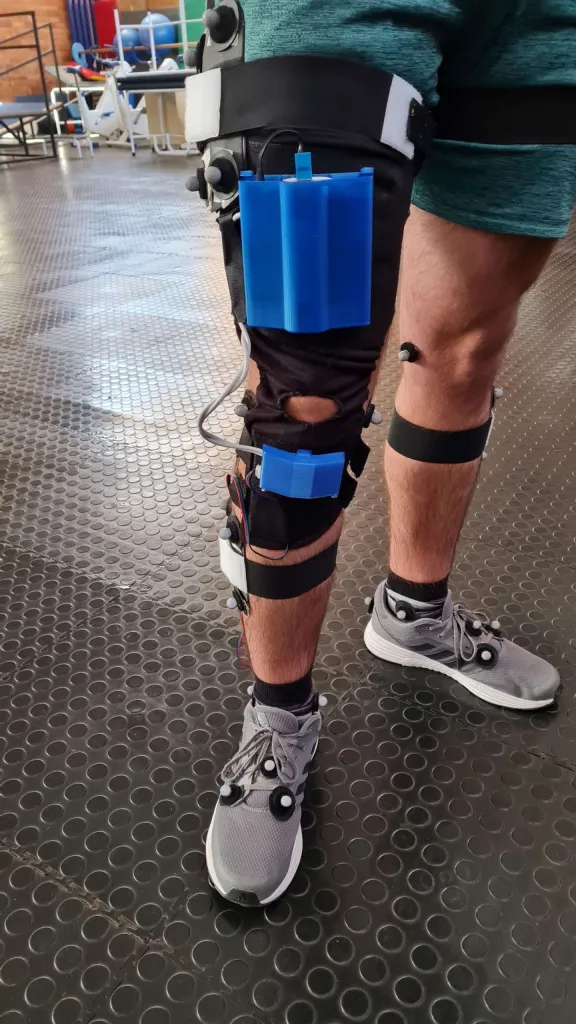In what is being hailed as a pioneering prototype that might well contribute to the advancement of the prosthetics industry, particularly in the African context, a South African master’s student has successfully built a high-tech knee brace that is the first of its kind.
Ian Thomson, working closely with Dr Mark Kramer, a biomechanics and exercise physiology specialist and senior lecturer at North-West University (NWU), says the development team hoped that the project would not only create awareness and develop expertise for a more Africa-centred approach to innovation in this field, but also make the equipment more affordable and readily available locally.
Thomson had one of his legs amputated just above the knee 11 years ago and as a prosthetics user has set his sights on making a difference in the industry, reports ThreeStreamsMedia.
Despite the brace being just a prototype, he has already started testing the technology, which is built into the brace.
“Ever since I lost my leg (in a motorcycle accident), I have wanted to make a contribution to the prosthetics industry,” he said. With Kramer’s contributions, he has developed an instrumented knee brace that continuously collects data of a patient’s knee function. Unlike traditional knee braces, which aim at limiting the strain on the injured joint, this brace allows health practitioners to utilise the data collected based on the patient’s day-to-day movements.
The technology is built into the brace, situated on key points to ensure the collected data is accurate and measurable. This allows practitioners to monitor the patient’s range of movement throughout the day, and not only when they have rehabilitation sessions.
The technology’s accuracy is currently being tested by using a motion analysis system and it has set a benchmark as it delivers sub-millimetre results.
Thomson’s long-term goal is to incorporate the technology into future prosthetics so that they can be developed according to the user’s needs.
The technology will not only create user-specific prosthetics, but could also be built into prosthetics to calculate the actions and movements the user is attempting, which allows the prosthetic to adapt to the specific scenario.
Kramer said: “A challenge facing our industry is that much of the equipment and technology needs to be imported, making it very expensive when considering the exchange rates. It is also a time-consuming process repairing equipment as it has to be sent back overseas.”
The motion analysis system referred to earlier can cost anything from R2m, whereas the brace can cut costs exponentially.
Cor Leijenaar, manager at the Centre for Health and Human Performance (CHHP) in NWU’s Faculty of Health Sciences, said technological advances like Thomson’s enable industry professionals to make decisions based on concrete evidence.
“Having measurable and accurate data could change our industry. It guarantees credibility as well because decisions can be based on a patient’s data rather than how they feel.”
Jean Stofberg, a biokineticist at the CHHP, said that such advances are important, as rehabilitation programmes can be adjusted based on data. “Concrete evidence ensures that the patient is indeed ready to move to a more advanced programme and they tend to buy into their rehabilitation, as they can see improvements on paper.”
This would guarantee that rehabilitation is more effective, as a health practitioner can make informed decisions based on the data that they have available.
Thomson and Kramer are also part of NWU’s 2024 Cybathlon team who will compete in Switzerland. Cybathlon is a competition in which physically-impaired individuals compete against each other to complete everyday tasks using technologically advanced assistance systems.
 Picture credit: Ian
Picture credit: Ian
ThreeStreamsMedia article – Brace yourself: Student hopes to change the prosthetics industry with knee innovation (Open access)
See more from MedicalBrief archives:
Wits engineering students lend a hand with cheaper prosthetics
Exoskeleton improves walking in patients with above-knee amputation
Paralympic rule change for ‘blade runners’ is contradicted by US study
WSU’s unaccredited medical orthotics and prosthetics degree a blow for students
